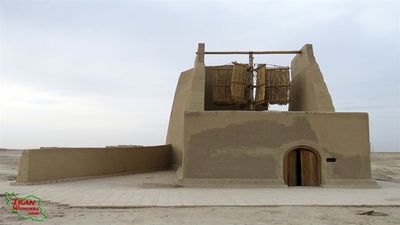The deputy head of the department, Mansoureh Molla-Elahi, said “In recent months, the process of completing the file for the global registration of the windmills across the province has accelerated, explaining that in the latest attempts, aerial photography of these valuable monuments has been on the agenda, chtn.ir reported.
The official from the province’s Cultural Heritage, Tourism and Handicrafts Department said there are seven windmills (asbads in Persian) in the region, adding that the windmills of Qal’e Rostam (Rostam Castle) in the historical area of Howzdar, the twin windmills of Qal’e Rostam, the small Machi Windmill, and others are among the windmills that the three provinces of Sistan and Balchestan, Khorasan Razavi, and South Khorasan are commonly pursuing the file for global registration.
Molla-Elahi added that the monuments have already been under restoration including strengthening the damaged parts, repairing brick decorations, applying thatch, etc., and according to the schedule, the case of the Sistan and Baluchestan’s windmills will be sent to the central headquarters by September of this year."
Windmill or asbad is one of the most significant architectural structures of Iran in its desert regions which converts the kinetic energy of air (wind) into other forms of energy.
Asbad is a smart technique to grind grains, a technique which goes back to ancient times when the people living in the eastern parts of Iran in an attempt to adapt themselves to nature and transform environmental obstacles into opportunities managed to invent it, whc.unesco.org wrote.
Iranian architects' smart utilization of a natural threat i.e. strong and annoying winds and rendering it to an exceptional opportunity for the production of a strategic product like bread is not short of a miracle.
As a result of the abundant and free of charge energy of wind in parts of the eastern region of Iran, one can see 40 windmills built side by side without any worry that energy may one day run out.
During the 120 days winds period, winds pass through the windcatcher openings and rotate the wheels and vanes, the heavyweight of the milling machinery and wheel is exerted on the axis and rotates the millstones.
The windmills are designed in such a way that winds encounter no obstacle to reaching them, as a result of this concern, windmills are built on high elevations. To make optimal use of the wind, all the uniform windmills of a village or town used to be concentrated at a single location on the highest spot of that area. Another reason for this strategy related to the fact that since all the windmills were built as a complex plant in a single area which sometimes stretched over an area of 1km wide, it acted as a barrier against the annoying storms for the nearby villages and towns. Therefore, it served two useful functions: Grinding grain and protecting the village and town against storms.
The two-story windmills designed horizontally had a vertical axis and the wood, mud, and brick were the main construction materials.
In Iran’s Khorasan Razavi Province, the millennium-old Nashtefan Windmills are still in use.
Located on the arid and windswept plains of northeastern Iran, the small village of Nashtefan is keeping ancient traditions alive amid the winds of change. The town is home to some of the earliest windmills in the world, and the structures are still in use today.
Source: Iran Daily

